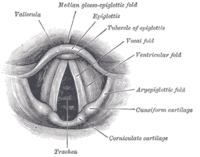
Photo from wikipedia
BackgroundRecent studies have suggested that the tumor necrosis factor-α (TNF-α) pathway is a potential target for the management of osteoarthritis (OA). Transforming growth factor (TGF)-β-activated kinase 1 (TAK1) is essential… Click to show full abstract
BackgroundRecent studies have suggested that the tumor necrosis factor-α (TNF-α) pathway is a potential target for the management of osteoarthritis (OA). Transforming growth factor (TGF)-β-activated kinase 1 (TAK1) is essential in several cytokine-mediated cascades, including the TNF-α, interleukin-1 (IL-1), and TGF-β pathways. The role of TAK1 in synovial tissue in OA is not fully understood. Using synovial cells harvested from OA patients during surgery, we investigated whether TAK1 inhibition suppresses production of TNF-α-induced extracellular matrix degrading enzymes and expression of pain-related molecules.MethodsSynovial tissues were harvested from ten subjects with radiographic evidence of osteoarthritis (OA) during total knee arthroplasty. Synovial cells were cultured and stimulated with control (culture media), 10 ng/mL human recombinant TNF-α, or 10 ng/mL TNF-α and 10 μM of the TAK1 inhibitor (5Z)-7-oxozeaenol for 24 h. Real-time polymerase chain reaction (PCR) analysis was used to monitor expression of mRNA of the extracellular matrix degrading enzymes matrix metalloproteinase-3 (MMP-3) and a disintegrin-like and metalloprotease (reprolysin type) with thrombospondin type 1 motif, 4 (ADAMTS-4); and of the pain-related molecules cyclooxygenase-2 (COX-2), microsomal prostaglandin E synthase-1 (mPGES-1), and nerve growth factor (NGF). MMP-3 and NGF protein concentrations in cell supernatant were measured by enzyme-linked immunosorbent assay (ELISA). COX-2, mPGES-1 and ADAMTS-4 protein expression was also evaluated by western blotting.ResultsTNF-α stimulated increases in ADAMTS-4 and MMP3 mRNA (2.0-fold and 1.6-fold, respectively, p < 0.05) and protein expression (21.5-fold and 2.0-fold, respectively). Treatment with the TAK1 inihibitor (5Z)-7-oxozeaenol reduced ADAMTS-4 and MMP3 mRNA (0.5-fold and 0.6-fold, respectively) and protein expression (1.4-fold and 0.5-fold, respectively) in OA synovial cells. COX-2, mPGES-1 and NGF mRNA (11.2-fold, 3.1-fold and 2.7-fold, respectively) and protein expression (3.0-fold, 2.7-fold and 2.2-fold, respectively) were increased by TNF-α. (5Z)-7-oxozeaenol treatment reduced mPGES1 and NGF mRNA (1.5-fold and 0.8-fold, respectively) and protein (1.5-fold and 0.5-fold, respectively).ConclusionTAK1 plays an important role in the regulation of TNF-α induced extracellular matrix degrading enzymes and pain-related molecule expression. TAK1 may be a potential target for therapeutic strategies aimed at preventing osteoarthritis progression and pain.
Journal Title: BMC Musculoskeletal Disorders
Year Published: 2017
Link to full text (if available)
Share on Social Media: Sign Up to like & get
recommendations!